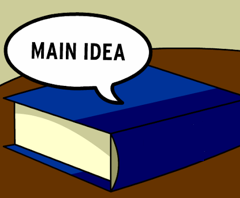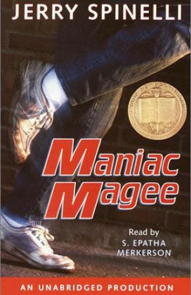Finding Main Ideas and Details in
Informational Texts

Unit Overview
In this unit you will learn how to determine the main
ideas and key details of informational texts. You will also learn about the
text feature: footnotes. Then, you will continue learning about Greek and
Latin roots and affixes along with correcting vague pronouns. Finally, you will
continue reading the novel Maniac Magee by Jerry Spinelli.
· I can determine a central idea of a text
and how it is conveyed through particular details... RI.6.2.
|
Academic
Talk Use these
words and phrases to talk about the text. |
|
informational
text topic central
idea supporting
details footnote reference
mark |
Watch the following video about finding the central
idea/main idea of a text.
Figuring out the central idea of an informational
text and the supporting details is necessary for understanding that text.
Remember, an informational text is nonfiction and teaches or explains a topic
to readers. A topic is what a passage is about. A text's central idea is the most important point the
writer is trying to make. Central idea is another way to say main idea.
Sometimes the central idea is directly stated, but more often it's not. Supporting details are
facts, examples, reasons, or descriptions that expand on the central idea.
Readers determine a text's central
idea and supporting details so they can better understand the text's meaning. A
central idea often needs to be figured out by analyzing the supporting details.
Think of yourself as a detective describing a complex situation and finding
clues to support your observations.
Guided Practice
Directions:
Read the passage below. What do you think is the main idea? Then look for key
details that help explain it.
Bartering:
A World Without Money It's hard
to imagine what things were like before there was money, but such a time did
exist. During these times people exchanged goods using the barter system. The word barter means to trade. People using
the barter system traded things instead of buying and selling them. So if you
were a rice farmer, you would trade your rice with many people to get all the
things that you wanted or needed. Unfortunately, the people from whom you
needed things might not want your rice. Isn't it nice to just go to the store
and buy candy instead of having to trade rice for it?
|
Hover your cursor over the
box to see if you were correct about the central idea.
 |
Text Feature Focus: Footnotes
Many of the passages you will read have reference marks with matching footnotes. A reference mark tells the reader that there is a footnote at the bottom of the page. When you see a reference mark, you should find the matching footnote. A footnote is a note with added information that is placed below the text on a printed page.

The reference mark always comes AFTER the word or phrase it is referencing. For example, in the above
passage the reference mark “1” comes after “genes.” You should look for the
footnote at the bottom of the page with the number “1” before it.
 |
A footnote is a note at the bottom of a page in a text which provides
more detailed information about something that is mentioned on that page. It is
essential to read the footnotes because they will provide context for the
passage- the reader will not be able to understand the passage fully without
reading them.
Lets look at the example
from above. In the above passage the reference mark “1” comes after “genes.”
You should look for the footnote at the bottom of the page with the number “1”
before it. This footnote reads “A "gene" is an instruction in a
living thing’s DNA that controls or influences a cell’s function, affecting the
living thing’s growth or appearance.” Without reading the footnote, you might
not understand what “genes” are and miss a key idea in the passage.
Let’s Practice!
Independent Practice
Genre Focus: The following informational article is a science
article. Science articles tell about events,
discoveries, and ideas in science. They might be about ideas and events
from the past, things happening now, or ideas for the future.
Read the following informational article “Things Get More
Complicated When You’re Older”.
Things Get More Complicated When You’re Older
Word Study
· I can use common,
grade-appropriate Greek or Latin affixes and roots as clues to the meaning of a
word (e.g., audience, auditory, audible). L6.4b
English
words come from many languages, including Greek and Latin.
A
root is a word part that usually can’t stand alone as a word. Sometimes
one root is added to another root to make a word. Affixes are word parts such
as prefixes and suffixes that are added to roots to make words. Knowing what affixes
and roots mean can help you figure out the meanings of words. As you learn
Greek and Latin roots and affixes, your vocabulary will grow.
During
the course of this class, you will be learning Greek and Latin roots, prefixes,
and suffixes- each unit a new one will be added to the chart below.
Di- is a prefix that
adds “two/through/across” onto a root. For example: digraph. The root graph
means “to write,” so a digraph is a combination of two letters
representing one sound, as in ph and ey.
Suffix |
Root |
Meaning |
Examples |
Additional Information |
|
en- em- |
|
|
to cause to be/to put into or onto/ to go into or onto |
encounter, enable, employ, embark, encircle |
|
fore- |
|
|
before/ earlier |
foreword, forearm |
|
de- |
|
|
reduce down/ away from |
defeat, deform, decrease |
|
trans- |
|
|
across/ change/ through |
transformation, transportation, transfer |
|
anti- |
|
|
opposite/ against |
antibiotic, antifreeze |
|
di- dia- |
|
|
two/ through/ across |
digraph, dialogue, diagonal |
|
Language Lesson: Correcting Vague Pronouns
· I can recognize and correct vague
pronouns (i.e., ones with unclear or ambiguous antecedents). L6.1d
Pronouns help writers to avoid
repetition, but when a pronoun is vague, or unclear, readers can't
tell what or whom it refers to.
Watch the following video about vague
pronouns.
A pronoun may be unclear if there is
more than one noun to which the pronoun could be referring. For example:
|
Clear: The cliff dwellings at
Mesa Verde were built by the Ancestral Pueblo people. Unclear: They show us what life was like
there thousands of years ago. |
The pronoun they could refer to
cliff dwellings or to Ancestral Pueblo people. You can fix the problem
by changing the pronoun to the correct noun.
|
Clear: These
dwellings show
us what life was like there thousands of years ago. |
A pronoun may also be unclear if there
is no noun to which the pronoun refers.
|
Unclear: Our days at Mesa Verde
were long and full, and it taught us a lot. Unclear: At home, people
sometimes asked questions, and it was hard. |
You can fix the first sentence by
replacing the pronoun with a noun phrase, such as the trip. However, the second
sentence might need a bit more work.
|
Clear: Our days at Mesa Verde
were long and full, and the trip taught us a lot. Clear: At home, people asked
questions that were hard to answer. |
Let’s Practice
Independent Reading
· I can read and comprehend literature
independently and proficiently. RL6.10
Maniac Magee by Jerry Spinelli: Reading Assignment - Chapters 8-9

Log your reading time in the Log Entry Question.
